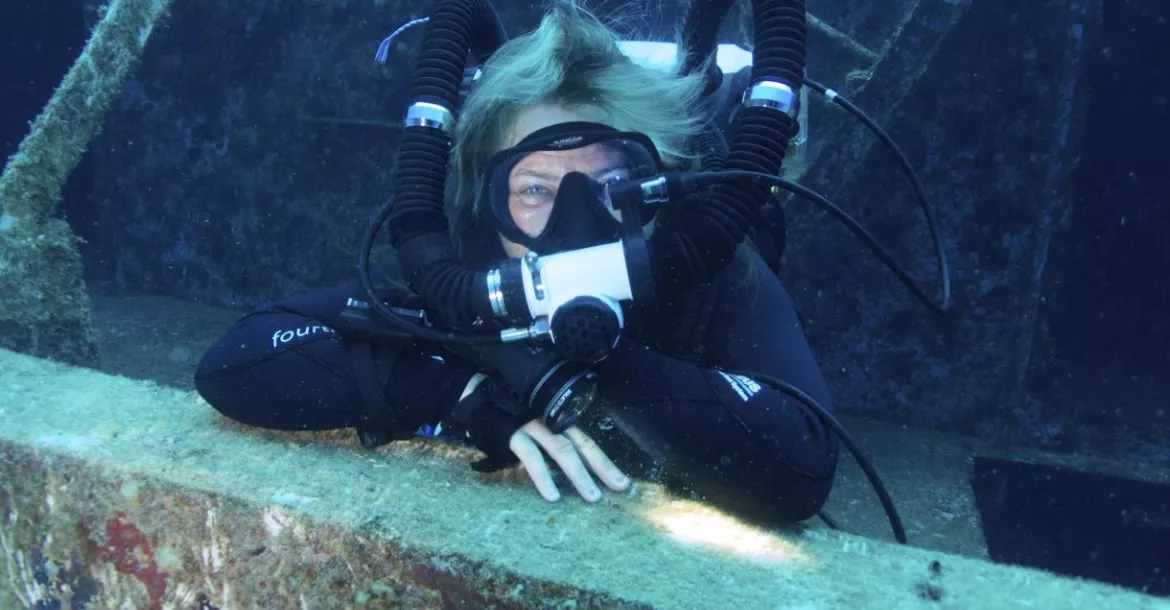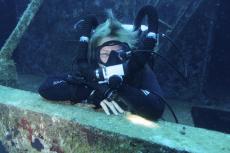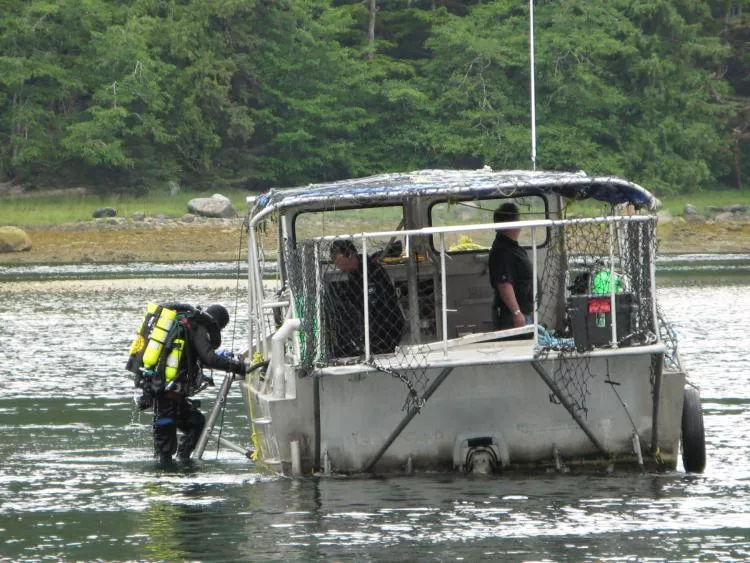A rebreather dive begins before you enter the water. You strap on the machine, put on your mask, or pinch your nose, and “pre-breathe” the unit for five minutes while monitoring the sensors and heads-up display (HUD) for any signs of trouble. It’s usually one of the last checklist items to complete before commencing the dive depending on the rebreather.
Contributed by
It’s the silence that first catches the attention, as you descend in the water column. There are no noisy bubbles. You can hear the soft whisper and rhythm of your own breathing and almost detect the beat of your heart. You relax and slow down. Often divers don’t notice that they are breathing warm moist “air” (actually a dynamic mix of nitrox or heliox) until sometime later in the dive. You feel warmer in comparison to scuba and not dehydrated.
“It’s like returning to womb of the mother,” said wildlife photographer and expedition leader Amos Nachum describing his early rebreather dives. To the wildlife around you, you’re no longer a noisy outside intruder but just another part of the food chain, so you can get up close and personal.
Couple this enhanced communion with the “silent world” with greatly extended bottom times (a combination of gas efficiency and minimizing inert gas uptake), and you can see why rebreathers have so much appeal.
Want to spend three hours exploring a reef system on a “no-stop” multilevel dive from 60 to 100 feet? Make two 90-min plus boat dives without changing out your cylinders? Or spend an hour at 100 feet with minimal decompression. You can!
Unlike open circuit scuba, rebreather dives are limited by the capacity of the scrubber—a canister containing absorbent material that removes the CO2—not gas volume, and typically provides up to 3-4 hours of dive time depending on your metabolism and the water temperature, essentially independent of depth.
As a result, the prospects of “running out of gas,” the number one factor in open circuit scuba fatalities, is no longer an issue. Nor is the stress of watching a dwindling SPG or buddying up with a heavy breather. For tech divers, the advantages of a rebreather are even more pronounced, enabling them to truly go where no open circuit diver has gone before.
A changing rebreather paradigm
Divers are hearing a lot more about the virtues of rebreather diving in the media. PADI Inc., the self-proclaimed “Way the World Learns to Dive,” is marketing a series of rebreather courses aimed specifically at recreational divers, and is supporting the effort with “Tec Xplorer Day” events and try-dives to promote rebreather diving. They also announced a series of technical diving rebreather programs.
Though other training agencies have offered “recreational” rebreather courses for some time, none have PADI’s sheer reach and marketing clout with more than 135,000 instructors and divemasters, and nearly 6,000 affiliated dive centres worldwide. It is expected that they will significantly expand the market for rebreathers. Call it a “Rec Revolution.”
Since their introduction to sport divers more than a decade and a half ago, rebreathers have become an essential tool in the technical diver’s arsenal. In many respects, they represent the ultimate fulfilment of the “technical diving (or mix) revolution” that began in the late 1980s, enabling divers to go deeper and stay longer than they could with conventional air-based scuba.
Today, rebreather diving represents the fastest growing segment of the tech diving market, and in some place like the United Kingdom, you’re likely to see more divers sporting rebreathers than sets of doubles.
Though a few well-healed recreational divers have purchased rebreathers, until recently, their cost, complexity, maintenance requirements and poor safety record have limited their use primarily to tech divers who needed their extended range capabilities.
But now, with the advent of more user-friendly next-generation machines, a decade and a half of industry training experience, and the rudiments of a global infrastructure in place to support rebreather travel, many industry experts say that the paradigm for rebreathers is about to change making them more widely available for recreational divers.
PADI’s recreational rebreather protocol is based on two important prerequisites. First, that the rebreather conform to their new “Type R” specification making them “suitable” for recreational diver use. For example, a Type R rebreather helps automate the required pre-dive checklist process, and will turn itself on if the user forgets. They also won’t operate without a scrubber canister present or the gas turned off and they have a built-in open circuit bailout valve in case of emergency. Second, that diving operations are limited to “no-stop” diving within the recreational envelope of 130 feet.
Advocates say that PADI’s entry into the rebreather market will help revitalize sport diving and increase the number of new divers while raising the bar on rebreather training. They compare recreational rebreathers to the introduction of snowboards in the then stagnant skiing industry in the late 70’s. Though resisted at first, the technology attracted needed young people to the sport which then grew by a factor of 60 times over the next 25 years.
“You’re too old if you think rebreathers won’t work for recreational divers,” said U.S. Navy Commander Joe Dituri, who serves as the vice president of the International Association of Nitrox and Technical Divers Inc. (IANTD) and trained his 15-year-old daughter to dive a rebreather. “Kids are smarter on electronics than we ever were, and they are goal oriented. I say get on board now or be left at the gate.” [Dituri’s views don’t necessarily reflect those of the U.S. Navy].
However, many industry watchers are concerned that with their operational complexity and poor safety reputation, the benefits of rebreathers may simply not justify the risks for recreational divers. Others like Technical Diving International (TDI) founder and former Uwatec CEO, Bret Gilliam, whose company marketed the Dräger Atlantis semi-closed rebreather to recreational divers in the late nineties before the machines were discontinued, says that rebreathers can meet the standard of “acceptable risk” if proper screening is put in place to weed out the unqualified participants.
Not so forgiving
“Just because you can afford one doesn’t mean that you possess the background of experience and skills to use a rebreather,” he said. “The overwhelming majority of sport divers are better off on open circuit, which is far more forgiving.”
But there is also trepidation. As the CEO of one rebreather manufacturer explained, “I am worried that it [PADI program] will result in a plethora of dead dentists, which will set the rebreather business back just like the Electrolung in late 60’s.” [Beckman Instruments pulled the $2,500 Electrolung—the first electronically-controlled closed circuit rebreather—from the sport diving market in 1970 after a series of high profile deaths.]
The work of (re)breathing
For all their benefits, rebreathers require more work and discipline than open circuit scuba. The late Dr Ed Thalmann, for senior medical director for the U.S. Navy Experimental Diving Unit (NEDU) who wrote all the physiological specs for U.S. Navy breathing apparatuses, once described a scuba regulator as the steam engine of diving. “They’ve been honed to a high degree and are incredibly reliable. By comparison,” he said, “a rebreather is like a space shuttle.” Though Thalmann’s analogy might seem far-flung, many people compare rebreather diving to instrument flying a small plane; the diver is in essence depending on his or her electronics to maintain and manage an artificial life-supporting atmosphere.
Subtle ways
Unlike open circuit, where failures like a free-flowing regulator, burst O-ring, or simply forgetting to crank open a tank valve all the way is immediately obvious; rebreathers often fail in subtle ways. In fact, the user might not even be aware of the problem, particularly if they’re distracted, until it’s a matter of survival.
Conversely, a rebreather gives divers many options to solve any problems that arise at depth and either continue or abort the dive.
Though today’s rebreathers are much more reliable than those of a decade ago, probabilistic analysis suggests that a rebreather, which is an electro-mechanical life support system, is still 20-times more likely to fail than a set of doubles due to their complexity.
However, incorporating redundant systems, e.g. adequate bail out, can mitigate this risk.
Then there is the on-going pre-dive and post-dive maintenance requirements, i.e. completing the 20-50 items on a pre-dive checklist, which includes a series of pre-dive tests and somewhat fewer post-dive, which can add up to a total of an hour or more of work per dive day compared to 30-45 minutes or less for conventional scuba gear.
And guess what? If you don’t complete the checklist each and every time you dive, when Murphy strikes, you could find your self in serious trouble or even die.
Still need tanks
Rebreathers do not eliminate the need for open-circuit scuba. In fact, you and your team need to carry, or stage all the open circuit gas required to bail out at the worst possible point in the dive. Rebreather veterans say that too many divers carry insufficient bailout. Some rebreather veterans say that you should plan to carry as much as 2-3 times the bail out gas volume that you think you need. “People forget that bail out gas is for themselves and their buddy,” said TDI instructor trainer, Steve Lewis. “They also underestimate their bailout-breathing rate, particularly in the event of a CO2 hit.”
Finally, in terms of expense, rebreathers cost approximately 2-3 times their open circuit equivalent, though this differential is likely to decrease as manufacturers’ volumes increase. Operations-wise, a dive day on the rebreather will likely cost you one and a half to two times as much as scuba.
For whom the bell tolls
At least one 181 divers died diving a rebreather between 1998 and 2010. Rebreather fatalities averaged approximately ten per year prior to 2005 and about 20 per year since, and it appears more than 20 rebreather divers have died since 2010 making the total number of deaths more than 200. Many of the deceased were diving’s best and brightest, and the toll on the community and particularly those who lost friends has been particular heavy. No one has counted the near misses.
To put these numbers in perspective, there was a combined total of about 100-120 sport diving fatalities per year on average in the United States, Canada, United Kingdom and Europe over the same period, which represents a large percentage of the worldwide sport diving market. (No one keeps worldwide diving fatality statistics.) On that basis, rebreather fatalities represent about 15 percent of the total each year.
But now consider that there are as many as 1-1.2 million active scuba divers in the United States alone, according to a 2007 analysis by Undercurrent (again there are no hard numbers) but likely no more than 10-15,000 rebreather divers worldwide. This would suggest that the fatality rate for rebreather diving is significantly higher than its open-circuit counterpart.
In 2011, Australian hyperbaric physician Dr Andrew Fock, an accomplished rebreather diver himself, set out to estimate the actual risk of rebreather diving by collecting and analysing data from the DAN, DAN-Asia Pacific, BSAC, Deep Life and Rebreather World databases. “They’re really best guest numbers,” explained Fock, who presented his findings last year at Rebreather Forum 3.0 in Orlando, Florida. “There are errors and incomplete data. We know the number of fatalities but no one knows how many rebreathers are in the field, the number of rebreather divers or how many dives they made.” In other words, we know the number of incidents but not the relevant denominator.
Fock’s conclusions? Rebreather diving may currently be as much as 8-10 times more risky than open circuit diving with a corresponding estimated incident rate of about 4 deaths/100,000 dives compared to a rate of .5 deaths/100,000 dives for scuba overall. Of course, some portion of this risk, is due to the fact that to date rebreathers have been primarily used to conduct deeper and longer “technical” dives. However, with scant data there is no way to quantify this extra risk.
Apples vs oranges?
It should also be considered, that historically fatality rates are often disproportionately high in the early phases of many “civilian” adventure sports such as flying small aircraft and hang gliding until participants are able create suitable safety paradigms; early technical diving is a case in point. Using Fock’s analysis to compare rebreather diving to other adventure sports, diving a rebreather is an order of magnitude less risky than base jumping at 43 deaths/100,000 jumps, but risker than sky diving at .99, hang gliding at .86 and horseback riding at .57.
Exploding heads
Statistics like this make defence attorneys’ heads explode. “Plaintiffs talk about safety statistics and try to use them to argue their case,” said David Concannon, who represents the Rebreather Education and Safety Association (RESA). “But they’re based on faulty statistical assumptions because we don’t know the denominator.
Concannon, a diver and ex-pilot who describes himself as “CCR Diver Zero” and consequently dives open circuit (“I’m 46, thick in the middle, only in the water 12-20 times a year, and I don’t take care of my equipment), won three of the five lawsuits that have been filed to date against manufacturers and agencies, and settled a third for nuisance value [one other suit is pending].
(...)
Published in
- Log in to post comments































